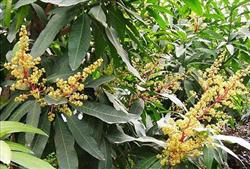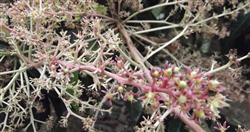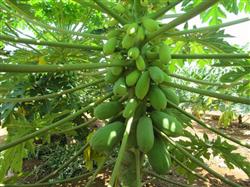The method of soil testing and formula fertilization for mango

It takes 1.74kg N, 0.23kg P2O5 and 2.0kg K2O to produce 1000 kg fresh mango. Potassium is the most needed, followed by nitrogen and phosphorus. In production, nitrogen, phosphorus and potassium fertilizers are generally applied according to N:P2O5:K2O=1:0.5:0.5-1, but the recommended amount of fertilizer for mango trees with different tree ages, different regions and different yield levels often varies greatly. The following is just a description of the general situation, and the application should be adjusted according to the local actual situation. 1. Mango fertilization for young trees focuses on promoting vegetative growth, developing root system, increasing the number of branches, expanding crown area, creating conditions for early fruiting and early high yield, fertilizing mainly with nitrogen and phosphorus, applying potassium fertilizer properly, applying more organic fertilizer as much as possible, strengthening soil fertilization, paying attention to orchard soil improvement, and laying the foundation for fruit. The main results are as follows: (1) the planting fertilizer is mainly organic fertilizer, combined with a small amount of phosphate fertilizer, applied into the planting pit. When the acidity of the soil is high, lime should be applied together, and the lime should be evenly scattered into the soil before fertilization, and then turned over to make the lime interact fully with the soil. The hole should be dug after an interval of 10-15 days, and then planted after the application of organic fertilizer. (2) topdressing should be applied in time after the young trees are planted and survived. Topdressing is mainly based on available nitrogen and phosphorus fertilizer, which promotes early emergence of new roots and shoots. Mango starts to shoot 1-2 months after planting, and shoots once every 2 months, and can be fertilized once after each shoot. Fertilization should be applied frequently and thinly for 1-2 years after planting, each plant with 20 grams of urea mixed with water or 5 kilograms of dilute dung water. With the increase of tree age, the amount of fertilizer application can increase, each plant with 40 grams of urea mixed with water or 10 kg of dilute dung water. In the autumn of the second year after planting, combined with hole expansion, one application of organic fertilizer, 25-50 kg of organic fertilizer and 0.5-1 kg of phosphate fertilizer per plant, or 0.5 kg of compound fertilizer. After that, 0.1-0.15 kg urea and 0.2-0.3 kg compound fertilizer were applied to each shoot, drenched with water or applied in shallow ditch. 2. The purpose of fertilization for fruiting trees is to promote fruit, improve yield and fruit quality, adjust tree nutrition and maintain soil fertility. The amount, type and period of fertilizer are different from those of young trees. Mango trees generally begin to bear fruit in the third year after planting and are officially put into production in the fourth year. It is suggested that the amount of chemical fertilizer applied to mango fruiting trees is 0.4-0.5kg N (0.90-1.1kg urea), 0.25kg-0.3kg P2O5 (1.6kg-1.8kg calcium magnesium phosphate fertilizer) and 0.360.4kg K2O (0.6kg-0.7kg potassium chloride) per plant in 4-5 years. After 6 years old, the application rates of N, P2O5 and K2O should be increased according to the plant yield. Mango fruit trees are mainly fertilized in four periods. The main results are as follows: (1) the flower bud differentiation period of mango is one month before flowering, and the flower bud differentiation period of mango in Guangxi is generally in December. Fertilization before flower bud differentiation can promote flower bud differentiation. Fertilizer should be mainly available nitrogen and potassium fertilizer, the dosage is about 20% of the annual use, each plant urea, potassium chloride 0.1-0.2 kg. (if phosphate fertilizer uses simple phosphate fertilizer, phosphate fertilizer can be applied in combination with phosphate fertilizer this time, generally applying calcium magnesium phosphate fertilizer 1.6-1.8 kg per plant.) Can be combined with foliar fertilization, using 0.2-0.3% potassium dihydrogen phosphate solution spray, spray to the leaf surface covered with water droplets, want to drop shall prevail, spray 2-3 times in a row, each time spraying interval 7-10 days. (2) strong flower fertilizer. Mango trees have a large amount of flowering and high nutrient consumption, so quick-acting nitrogen fertilizer should be applied once at flowering stage. The fertilization time depends on the tree potential, plant status and weather. However, it must be fertilized at the right time, and it is appropriate to start fertilizing when 50% of the last shoots of the plant are budding. Otherwise, if the tree is strong and prosperous, the temperature rises, and fertilization is too early, it can induce the germination of too many nutritious shoots or mixed flower branches and reduce the number of flowers. Strong flower fertilizer can choose urea or compound fertilizer, each plant urea or compound fertilizer 0.1-0.15 kg, can be combined with foliar spraying 0.1% borax, 0.2% color 0.3% potassium dihydrogen phosphate solution. If the application of flower fertilizer is sufficient and the plant grows vigorously, the fertilizer can not be applied this time. (3) strong fruit fertilizer. About 30 days after flowering is the period of rapid growth and development of fruit. During the period of rapid increase of young fruit, it is necessary to apply strong fruit fertilizer to meet the nutrient needs of fruit development. Generally, 0.3-0.4 kg urea and 0.2-0.3 kg potassium chloride are applied to each plant. (if there is no combined application of phosphate fertilizer in flower-promoting fertilizer, 1.6-1.8 kg of calcium-magnesium phosphate fertilizer can be applied this time.) Can be combined with foliar fertilization, 0.2% color 0.3% urea plus potassium dihydrogen phosphate solution spray, spray to the leaf surface covered with water droplets, want to drop shall prevail, spray 2-3 times in a row, each time spraying interval 7-10 days. (4) mango has a large amount of fruit and consumes a lot of nutrients before and after fruit harvesting. If it is not supplied and replenished in time, it will be difficult to restore the tree potential and affect the germination of autumn shoots. Fertilization before and after fruit harvest is very important, and it is better to apply it in two stages. Before and after fruit picking for the first time, 0.2-0.3 kg urea and 0.1-0.2 kg potassium chloride were applied to each plant to promote the restoration of tree potential and sprout autumn shoots as soon as possible. When the second fertilization began to turn green in the last shoot, the weeds were buried in the soil, and 25-50 kg of organic fertilizer and 0.5 kg of ternary compound fertilizer were applied to each plant. Can be combined with foliar spraying 0.3% potassium dihydrogen phosphate solution 1-2 times. 3. The method of fertilization: annular ditch and strip ditch are mainly used in soil fertilization, and the soil is covered after application. ① annular trench fertilization: digging annular or semicircular trench outside the crown drip line, 15-20cm wide and deep. ②, strip-furrow fertilization: every year, two parallel trenches are symmetrically dug on the outside of the crown dripping, 20-30cm wide and deep, and the ditch depth is more than 60cm when expanding holes to improve soil.
- Prev

Key points of flower and fruit management in mango orchard
(1) use of plant growth regulators: plant growth regulators must be used in accordance with the prescribed concentration, method and time of use, and plant growth regulators registered and produced without the approval of the State shall not be used. As a plant growth regulator for controlling shoots and promoting flowers, the recommended concentration is ethephon 200 ~ 3.
- Next

Cultivation and management techniques of papaya
1. Select excellent varieties. Suitable for local varieties are Yizhou papaya, poinsettia papaya and so on, and can pollinate each other. 2. Planting and establishing the garden. It is appropriate to choose loam or sandy loam with deep and fertile soil layer, good drainage, neutral or slightly alkaline soil. The row spacing is 2.5 m × 4 m. Dig 1 m long, 1 m wide and 0.8 m deep before planting.
Related
- Moge, come on! The staff of the peasant association in the producing area of cantaloupe were frightened when the crowd gathered.
- Causes and Solutions of low Fruit setting rate of Apple
- Symptoms and control measures of passion fruit virus disease
- Fruit growing lesson: how do apple orchards keep high yields?
- Can you build orchards in the mountains? What are the pros and cons?
- How to manage the coloring period of Crisson grape?
- This paper introduces the processing technology of two kinds of fig products.
- How much is a month for retired teachers in rural areas by 2020?
- How can strawberry planting increase sugar content? We should pay attention to management in many aspects.
- What are the cultivation techniques on how to improve the yield of golden fruit?

